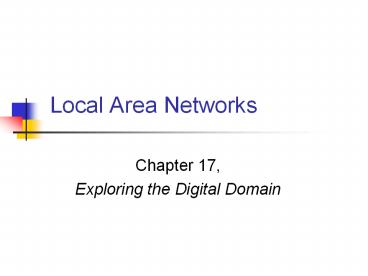Local Area Networks - PowerPoint PPT Presentation
1 / 19
Title:
Local Area Networks
Description:
REPEATERS: boost signal strength over medium ... mobile. transitory. WLAN Standards. HomeRF. 2.4 GHz, 2 - 10 Mbps, 100-150 ft. Wi-Fi (802.11b) ... – PowerPoint PPT presentation
Number of Views:54
Avg rating:3.0/5.0
Title: Local Area Networks
1
Local Area Networks
- Chapter 17,
- Exploring the Digital Domain
2
In this chapter . . .
You will learn about
- the characteristics and advantages of LANs
- how devices in LANs are connected and transmit
data - how communication is organized among competing
nodes - how software facilitates networks
- ways to extend LAN size and performance
- how wireless LANs are organized and communicate
3
Basic Characteristics of LANs
- connectivity supporting two-way communication
- resource sharing
- limited geographical area
- transparency of use
- support from hardware and software
4
Costs and Benefits
costs
benefits
- need for additional equipment
- maintenance
- support staff
- communications
- management control
- cost-effectiveness
5
Transmission Media
bounded media
unbounded media
- twisted-pair cable
- UTP CAT-n
- coaxial cable
- optical fiber cable
- infrared transmission
- radio frequency broadcasting
- cellular network transmissions
6
Topologies
- star
- bus
- ring
star topology has a single node that serves as
the hub and central switching node for the rest
of the network
7
Topologies
- bus
bus topology is a single medium on which all
of the nodes are connected
8
Topologies
- ring
a ring topology is a closed path that is
directional signals are passed from node to node
9
Media Access Control
- Ethernet (AKA Carrier Sense Multiple Access with
Collision Detection) - nodes listen for silence on the bus
- when carrier is silent, node transmits packet
- if no collisions, transmission continues
- but if collisions, backoff procedure invoked
10
Media Access Control
- Token Passing
- node can capture a free token
- packets are transmitted via token to successor
- token transmitted from node to node
- acknowledged token eventually returned to sender
11
Media Access Control
token passing
12
Networking Software
- physical layer supports basic carrier signals
- data link layer manages point-to-point
connectivity - network layer routes data from sender to
destination - transport layer provides messaging services
- applications layer provide user functions
13
Extending LANs
- REPEATERS boost signal strength over medium
- BRIDGES isolate LANs from unnecessary traffic,
but connect LANs to neighboring networks - SWITCHES provide dedicated and shared
connections for large numbers of nodes - ROUTERS connect same or different protocol nets
14
Extending LANs
15
Wireless LANs
- infrared broadcasting
- radio frequency broadcasting
- spread spectrum (cell telephony)
- direct sequence spread spectrum (DSSS)
- frequency hopping spread spectrum (FHSS)
16
WLAN Topology
- Basic Service Set (BSS)
- access points (AP)
- Stationary
- nodes
- mobile
17
WLAN Topology
- ad hoc network
- temporary
- nodes
- mobile
- transitory
18
WLAN Standards
- HomeRF
- 2.4 GHz, 2 - 10 Mbps, 100-150 ft.
- Wi-Fi (802.11b)
- 2.4 GHz, 2 - 11 Mbps, 200 - 400 ft.
- 802.11a
- 5 GHz, up to 54 Mbps
- 802.11g
- 2.4 GHz, up to 54 Mbps
19
Personal Area Networks
- PAN -- a group of digital devices assembled in a
small area to communicate and share information - Bluetooth
- 2.4 GHz, 1 Mbps
- FHSS
- up to 7 simultaneous connections































